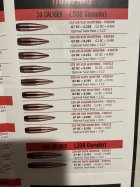When contemplating the 185gn Juggernaut, consider that when ballistics guru Bryan Litz who is responsible for Berger's stability calculator was a top sling shooter, he won a lot of matches and a major US series firing the Juggernaut from a
13-inch twist barrel. At the time, he considered 12 as ideal for the bullet in 308 and intended to use that on next rebarreling. (A 12-twist barrel gives this bullet 1.43 Sg at 2,800 fps MV in 'standard' ballistic conditions.)
This was a few years before research showed an optimal Sg value of 1.5 which has since seen a widespread reappraisal of practices in this field. At least one generation of long-range competitive shooters had previously relied on Miller's Twist Rule calculations and the then recommended optimal Sg value of 1.4.
Barrel/bullet combinations producing yet lower Sg values work perfectly well too in stabilising bullets well enough to produce excellent groups particularly at shorter distances. For historical reasons UK and British Commonwealth sling shooters ('Target Rifle' is the official name for the discipline) exclusively fired 7.62mm Nato issued ammunition for many generations. Even in its Radway Green (British ammunition factory, now privatised and part of British Aerospace) 'Green Spot' 146gn FMJBT so-called sniper version, this was dire quality compared to the worst production batch that Berger Bullets say has turned out in its entire history, so rifles were in effect substantially modified to wring the best out of a poor product. The two main 'fixes' were very undersize internal dimensions, and the very slowest twist rate that would work. (When you have poorly balanced bullets due to inconsistent jacket thickness, the higher the rotational rate the greater the degree of dispersion in flight.) The standard rate used was one turn in 14". Even when the discipline moved onto 155gn sniper ammunition, many competitors stuck with 14 twist barrels and they shot extremely well out to 1,000 yards on Bisley's Stickledown Range, a low lying venue so no help in stabilisation from significant altitude. (Nevertheless 13 twist barrels gradually took over as in the US and remain the most widely used rate today for those shooting under ICFRA rules limiting bullets
to less than 156gn weight.)
I acquired such a 'TR' rifle some years ago with a (very!) well-used stainless Lothar Walther 14 twist barrel that still shot very well despite a massively extended throat from thousands of rounds through it. (I soon discovered it was one of the very 'tight' barrels too when usually mild 308 handloads turned out to be over-pressure!) It shot the 168s from Speer, Hornady and Sierra extremely well on a range just under 1,000 ft ASL, likewise the 175 Sierra MK at relatively low MVs. It continued to shoot the original shorter Sierra MK (2155) superbly which its previous owner had shot through it for many years. These bullets all produce Sg values hovering around the previous norm, ie 1.4 in
14 twist at long-barrel 308 MVs from mild loads. So 12-twist is super stabilisation by comparison and easily copes with much longer/heavier bullets. As
@Ned Ludd points out, you incur a small BC loss penalty though in many cases. I doubt if a competent shooter would notice the difference, and quite obviously Bryan Litz (a super-competent shooter) didn't when he was winning matches all over the place 10 years ago with a theoretically under-stabilised 185 Juggernaut.












